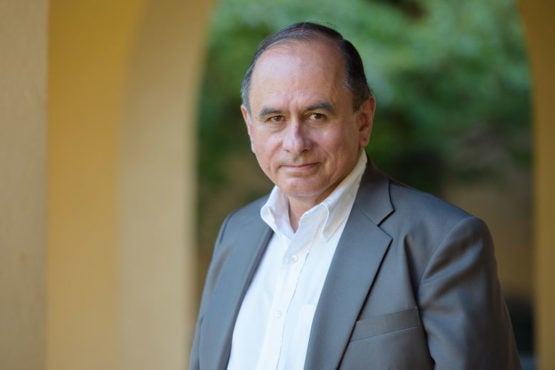Stanford launches IDEAL Provostial Fellows Program to bring early-career scholars of race and ethnicity to the university
Vice Provost for Faculty Development, Diversity and Engagement C. Matthew Snipp talks about the new program and the challenge of diversifying Stanford’s faculty.
Stanford Provost Persis Drell has said, “We believe that the Stanford community – students, faculty, staff and postdoctoral scholars – should reflect the multi-racial, multi-ethnic and pluralistic society that we live in today. To put it another way, a diverse student body needs to see a diverse faculty. And that’s a big challenge – a national challenge.”

C. Matthew Snipp is vice provost of faculty diversity, development and engagement. He is also the Burnet C. and Mildred Finley Wohlford Professor of Humanities and Sciences in the Department of Sociology. In addition, he is the director of the Secure Data Center at the Institute for Research in the Social Sciences. (Image credit: L.A. Cicero)
C. Matthew Snipp, vice provost for faculty development, diversity and engagement, has been working on this challenge for several years. His office recently launched the IDEAL Provostial Fellows for Studies in Race and Ethnicity program, an effort to bring four to five early-career scholars engaged in the study of race and ethnicity to Stanford, where they will continue or expand on their doctoral research.
Stanford Report spoke with Snipp about this new program and why it’s so important now, as well as other efforts to promote faculty diversity at Stanford.
What are the goals for this program?
The program has a number of goals. In the short term, it will increase the amount of research and teaching related to race and ethnicity at the university. It will be an opportunity for undergraduate and graduate students and faculty to interact with some of the most promising young scholars in the nation doing research about the impacts of race and ethnicity. Longer term, it will burnish the university’s already excellent reputation in this work and there may be opportunities to recruit these individuals to the Stanford faculty and enhance the diversity of our faculty.
What are the criteria for selecting the scholars?
A faculty committee will select the fellows by reviewing applicant CVs, letters of recommendation, statements written by the applicants and samples of their written work. In much the same way that assistant professors are selected, the committee will look for academic promise, excellence in their research, talent and originality that make them the best among the best at this early stage in their career.
The committee currently includes Anthony Antonio (associate professor, Graduate School of Education); Rick Banks (professor and associate dean for curriculum, Law School); Jennifer Brody (professor of theater and performance studies, School of Humanities and Sciences); Tomas Jimenez (professor of sociology, School of Humanities and Sciences); Dale Miller (professor, Graduate School of Business); and Vaughn Rasberry (professor of English, School of Humanities and Sciences). I also serve on the committee as an ex officio member.
What fields of study are eligible for consideration?
All fields are eligible for consideration as long as the applicant’s work has a clear focus on race and ethnicity.
How do you think having these scholars will affect Stanford?
They will be a resource for our students and faculty and enrich the community of scholars concerned with race and ethnicity with new ideas, new methodologies and new ways of looking at these issues. They also will be role models for our students, especially our undergrads.
When do you expect the scholars will arrive and what will their duties be? How will Stanford support them?
We expect to bring the first cohort of fellows to Stanford in September 2021. They will be expected to continue their research, engage with colleagues in their department and in programs like the Center for Comparative Studies in Race and Ethnicity, connect with the community centers and be available for consultation with undergraduate and graduate students. In addition, they will teach one course each year of their residence. They will have mentors from their respective departments and elsewhere around the university. The Office of Faculty Development, Diversity, and Engagement will be regularly involved with them to ensure that they have the resources that they need for their scholarship. They also will have access to the resources provided by the Office of Postdoctoral Affairs.
Why is diversifying the faculty important and why is it such a challenge?
To paraphrase Provost Persis Drell, higher education has the mission to advance human welfare in a rapidly changing world. We recognize that only institutions that are truly inclusive, and that embrace and advance diversity, will be able to achieve this mission. This imperative is embedded in Stanford’s Long-Range Vision through the IDEAL (Inclusion, Diversity, Equity and Access in a Learning Environment) initiative. It is a challenge because we are in an intense competition with our peer institutions striving to achieve the same goal.
How diverse is Stanford’s faculty currently?
We have 167 faculty who identify as underrepresented minorities, about 7 percent of the total faculty.
More data on the faculty is available on the IDEAL Dashboard, which shows the composition of the Stanford community from 2010 to the present.
What are some of the other efforts your office is doing to promote faculty diversity?
Our office administers the Faculty Development Initiative and we also work with the Faculty Incentive Fund program that is overseen by Bob Weisberg (special assistant to the provost for faculty recruitment and retention; professor and associate dean for curriculum, Law School). In addition, Susan Drange in our office works with departmental search committees to deploy strategies that will yield diverse applicant pools.
The deadline for applying for the IDEAL Provostial Scholars Program is November 1. For more information, visit the Faculty Development, Diversity and Engagement website.
